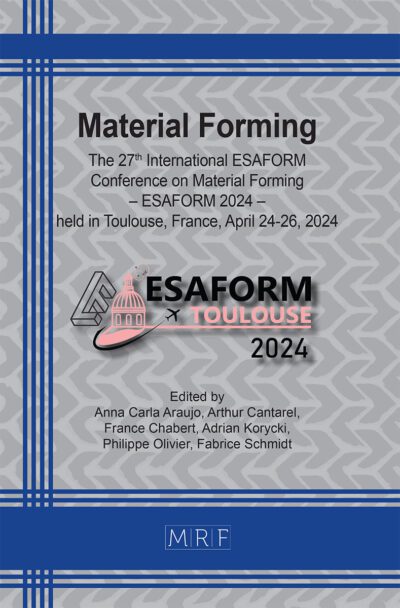Study of correlation between scraps and main process parameters in flow-forming alloy wheels production
Alessandro Trevisani, Andrea Abeni, Paola Serena Ginestra, Alessio Franchi, Alessandro Concoreggi, Mauro Silvestri, Elisabetta Ceretti
Abstract. Flow-forming is a metalworking process that can be employed to produce lightweight, high-strength components by plastically deforming materials using circumferential and axial forces. This technique is employed in the automotive industry, particularly for wheel manufacturing, allowing a reduction of weight and an enhancement of the mechanical properties. The process has been extensively studied to investigate its influence on the final properties such as tensile strength, surface roughness, and fatigue resistance. However, challenges such as residual stress, defects, and micro-cracks remain crucial for optimizing final product quality. The study investigates the defects distribution after flow-forming of aluminium alloy (AlSi7Mg0.3) wheels. The process involves heating pre-formed wheels to a target temperature higher than 400°C, followed by controlled plastic deformation using two rollers that reshape the material. Data on the process, such as spindle speed, material temperature, and machine downtimes, were collected from five flow-forming stations over a 23-week production period. Analysis of the data was conducted using the statistical methods ANOVA and DOE to correlate process variations with the occurrence of defects on products. Once the most impactful process parameters were identified, FEM methods were utilized to correlate the parameters with the temperature distribution in the parts and with the geometry achieved by the deformation. Furthermore, the numerical model of the process was utilized to investigate the effects of machine downtimes, defining a methodology to individuate and tackle the most relevant issues in flow-forming processes.
Keywords
Flow-Forming, Automotive, Alloy Wheels, Light Alloys, DOE, Quality Management
Published online 5/7/2025, 10 pages
Copyright © 2025 by the author(s)
Published under license by Materials Research Forum LLC., Millersville PA, USA
Citation: Alessandro Trevisani, Andrea Abeni, Paola Serena Ginestra, Alessio Franchi, Alessandro Concoreggi, Mauro Silvestri, Elisabetta Ceretti, Study of correlation between scraps and main process parameters in flow-forming alloy wheels production, Materials Research Proceedings, Vol. 54, pp 946-955, 2025
DOI: https://doi.org/10.21741/9781644903599-101
The article was published as article 101 of the book Material Forming
![]() Content from this work may be used under the terms of the Creative Commons Attribution 3.0 license. Any further distribution of this work must maintain attribution to the author(s) and the title of the work, journal citation and DOI.
Content from this work may be used under the terms of the Creative Commons Attribution 3.0 license. Any further distribution of this work must maintain attribution to the author(s) and the title of the work, journal citation and DOI.
References
[1] M. Kleiner, M. Geiger, A. Klaus, Manufacturing of lightweight components by metal forming, CIRP Ann. Manuf. Technol. 52 (2003) 521-542. https://doi.org/10.1016/S0007-8506(07)60202-9
[2] S.Y. Hwang, N. Kim, C.S. Lee, Numerical investigation on the effect of process parameters during aluminum wheel flow-forming, Stroj. Vestn. – J. Mech. Eng. 61 (2015) 471-476. https://doi.org/10.5545/sv-jme.2014.2180
[3] W.J. Chen, Y. Xu, H.W. Song, S.H. Zhang, S.F. Chen, L.L. Xia, et al., A novel hydroforming process by combining internal and external pressures for high-strength steel wheel rims, Materials 15 (2022) 6820. https://doi.org/10.3390/ma15196820
[4] M. Zanchini, D. Longhi, S. Mantovani, F. Puglisi, M. Giacalone, Fatigue and failure analysis of aluminium and composite automotive wheel rims: Experimental and numerical investigation, Eng. Fail. Anal. 146 (2023) 107064. https://doi.org/10.1016/j.engfailanal.2023.107064
[5] K. DeMarco, J. Stratton, K. Chinavare, G. VanHouten, The Effects of Mass and Wheel Aerodynamics on Vehicle Fuel Economy, SAE Tech. Pap. (2017) 2017-01-1533. https://doi.org/10.4271/2017-01-1533
[6] H.R. Molladavoudi, F. Djavanroodi, Experimental study of thickness reduction effects on mechanical properties and spinning accuracy of aluminum 7075-O, during flow forming, Int. J. Adv. Manuf. Technol. 52 (2011) 949-957. https://doi.org/10.1007/s00170-010-2782-4
[7] M.J. Roy, D.M. Maijer, J. Zhao, Fatigue characterization of flow-formed A356-T6, MATEC Web Conf. 12 (2014) 03001. https://doi.org/10.1051/matecconf/20141203001
[8] D. Marini, D. Cunningham, J. Corney, A review of flow forming processes and mechanisms, Key Eng. Mater. 651 (2015) 750-758. https://doi.org/10.4028/www.scientific.net/KEM.651-653.750 https://doi.org/10.4028/www.scientific.net/KEM.651-653.750
[9] A. D’Annibale, A. Di Ilio, A. Paoletti, D. Paoletti, S. Sfarra, The combination of advanced tools for parameters investigation and tools maintenance in flow forming process, Procedia CIRP 59 (2017) 144-149. https://doi.org/10.1016/j.procir.2016.09.038
[10] M.J. Davidson, K. Balasubramanian, G.R.N. Tagore, Experimental investigation on flow-forming of AA6061 alloy-a Taguchi approach, J. Mater. Process. Technol. 200 (2008) 283-287. https://doi.org/10.1016/j.jmatprotec.2007.09.026
[11] M. Haghshenas, M. Jhaver, R.J. Klassen, J.T. Wood, Plastic strain distribution during splined-mandrel flow forming, Mater. Des. 32 (2011) 3629-3636. https://doi.org/10.1016/j.matdes.2011.02.014
[12] M. Jahazi, G. Ebrahimi, The influence of flow-forming parameters and microstructure on the quality of a D6ac steel, J. Mater. Process. Technol. 103 (2000) 362-366. https://doi.org/10.1016/S0924-0136(00)00508-2
[13] M. Srinivasulu, M. Komaraiah, C.S.K.P. Rao, Experimental studies on the characteristics of AA6082 flow-formed tubes, J. Mech. Eng. Res. 4 (2012) 192-198.
[14] R.K. Gupta, B.R. Ghosh, V.A. Kumar, M.K. Karthikeyan, P.P. Sinha, Investigation of cracks generated during flow forming of Nb-Hf-Ti alloy sheet, J. Fail. Anal. Prev. 7 (2007) 424-428. https://doi.org/10.1007/s11668-007-9089-2
[15] Q. Jiang, Z. Zhao, Z. Xu, J. Sun, X. Chen, B. Su, et al., Effect of residual stresses on wheel fatigue life and experimental validation, Machines 10 (2022) 924. https://doi.org/10.3390/machines10100924
[16] M. H., Parsa, A. A. Pazooki, M. Nili Ahmadabadi, Flow-forming and flow formability simulation, The International Journal of Advanced Manufacturing Technology 42 (2009) 463-473. https://doi.org/10.1007/s00170-008-1624-0
[17] C. Cappellini, L. Giorleo, G. Allegri, A. Attanasio, E. Ceretti, A digital twin approach to automotive wheel flow forming process, In International Symposium on Industrial Engineering and Automation (2022) 114-126. Cham: Springer International Publishing. https://doi.org/10.1007/978-3-031-14317-5_10














